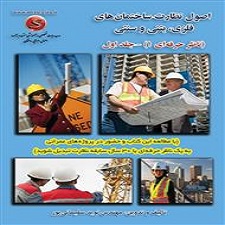توضیحات
چکیده
با توجه به توسعه روزافزون و هزينه هاي بالاي ساخت سازه هاي زيرزميني و نيز اهميت آنها در شبكه حمل و نقل بين شهري و داخل شهري و خطرات ناشي از آسيب ديدگي آنها، لازم است كه نحوه احداث و مديريت در نگهداري آنها مورد بررسي قرار گيرد. در اين راستا در بعضي از اين موارد پروژه هايي، در زمين هاي مسأله دار مانند مناطق آماس پذير انجام مي شود. از آنجايي كه خاك آماس پذير مسائل بزرگي در حفاري ايجاد مي كند، اغلب چالش ويژه اي براي تونل سازي مي باشد. در چندين مورد ديده شده كه اجراي تونل در زمين هاي آماس پذير سبب فروريزش و در تيجه آن خسارات زياد مالي و تأخير در پروژه شده است. در اين مقاله به معرفي عوامل جابجايي زمين ناشي از حفر تونل مانند شرايط زمين شناسي، عمق و هندسه تونل، روش حفاري و كيفيت انجام كار و مديريت پرداخته شده و با درنظر گرفتن حفر تونل در زمين هاي آماس پذير تمهيداتي براي كنترل و پايداري نشست در نظر گرفته شده است.
مقدمه
فن تونل سازي سابقه ديرينه اي در كشور ما دارد. حدود 3000سال پيش، نياكان ما با حفر قنات ها كه در واقع تونل هاي قديمي هستند، به آب زيرزميني دست مي يافتند و به كمك آنها، آب را به سطح زمين هدايت مي كردند. در تعاريف قديمي تونل به عنوان يك راهروي طويل زيرزميني تعريف شده است كه امروزه براي مصارف گوناگون از جمله استخراج مواد معدني، رفت وآمد اتومبيل ها، حركت قطار ها، انتقال لوله و كانال و نيز انتقال آب احداث مي شود. قديمي ترين تونل شناخته شده در حدود 4000سال پيش در بين النهرين حفر شده است. تونل سازي همزمان با انقلاب صنعتي، به ويژه به منظور حمل ونقل، تحرك قابل ملاحظه اي يافت و اين امر در توسعه صنعت بويژه در قرون 18و 19ميلادي انگلستان سهم بسزايي داشت. بررسي وضعيت تنش در اطراف تونل ها و همچنين پايداري و ناپايداري در مورد حفريات زيرزميني، از جمله پارامتر هاي موثر در طراحي اين سازه ها است. محيط زمين درا ابتد تحت تنش ناشي از تنشهاي طبيعي زمين بوده ثرا بر كه حفر تونل اشر يط تنش ز در مين تغيير ميكند، ر ما ينا كه موجب انقباض دهانه تونل و بوجود آوردن تغيير شكلهايي در مقطع زمين مي شود، كه نهايتاً به نشست سطحي زمين منجر ميشود.
ABSTRACT
Considering the increasing development and high costs of construction of underground structures and their importance in the inter-urban and inland transportation network and the risks of their damage, it is necessary to consider how to construct and manage them in their maintenance. In this regard, in some of these cases, projects are being carried out in problematic areas such as inflammable areas. Since inflammable soil causes large digging problems, it is often a special challenge for tunneling. In several cases, it has been observed that the implementation of the tunnel on inflammable grounds has led to collapse and has resulted in high financial losses and delays in the project. In this paper, we introduce the factors of land displacement due to tunneling, such as geological conditions, tunnel depth and geometry, drilling method and the quality of work and management, and considering tunneling in irrigable lands, arrangements for control and stability of the site opnions have been asked.
INTRODUCTION
Tunneling fan has a long history in our country. About three thousand years ago, our ancestors dug underground water through the excavations of old tunnels, and, with their help, they led the water to the surface of the earth. In the old definitions, the tunnel is defined as a long underground corridor, which today is being constructed for various uses, such as extraction of minerals, carriages, trains, pipelines and canals, as well as water conveyance. The oldest known tunnel was drilled in Mesopotamia about 4,000 years ago. Tunneling along with the industrial revolution, especially for transportation, has found considerable mobility, and this contributed significantly to the development of industry, especially in the 18th and 19th centuries of England. Investigating the tensions around tunnels, as well as the stability and instability of underground caverns, is one of the effective parameters in designing these structures. The Earth’s environment was initially subjected to tension caused by natural tensions on the earth, and the effect of the excavation of the tunnel on the Earth’s tension fluctuates, which causes the tunnel to shrink and cause changes in the shape of the earth, which ultimately leads to a surface Earth leads.
Year: 2011
Publisher : Sixth National Congress on Civil Engineering
By : Saeed Hesami, Mohammad Bararpour, Alaleh Shakeri
File Information: persian Language/ 7 Page / size: 254 KB
Only site members can download free of charge after registering and adding to the cart
سال : 1390
ناشر : ششمین کنـگره ملی مهنـدسی عمـران
کاری از : سعيد حسامي ،محمد برارپور ، آلاله شاكري
اطلاعات فایل : زبان فارسی / 7 صفحه / حجم : KB 254









نقد و بررسیها
هنوز بررسیای ثبت نشده است.